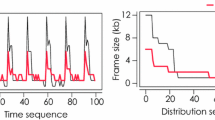Abstract
This work investigates the modeling of aggregate available bandwidth in multi-sender network applications. Unlike the well-established client–server model, where there is only one server sending the requested data, the available bandwidth of multiple senders when combined together does exhibit consistent properties and thus can be modeled and estimated. Through extensive experiments conducted in the Internet this work proposed to model the aggregate available bandwidth using a normal distribution and then illustrates its application through a hybrid download-streaming algorithm and a playback-adaptive streaming algorithm for video delivery under different bandwidth availability scenarios. This new multi-source bandwidth model opens a new way to provide probabilistic performance guarantee in best-effort networks such as the Internet, and is particularly suitable for the emerging peer-to-peer applications, where having multiple sources is the norm rather than the exception.
Similar content being viewed by others
References
Agarwal V, Rejaie R (2005) Adaptive multi-source streaming in heterogeneous peer-to-peer networks. SPIE conference on multimedia computing and networking, San Jose, California, January 2005
Golubchik L, Lui JCS, Muntz RR (1995) Reducing I/O demands in video-on-demand storage servers. ACM SIGMETRICS and PERFORMANCE’95, International conference on measurement and modeling of computer systems, Ottawa, Canada, May 1995
Hahn GJ, Shapiro SS (1994) Statistical models in engineering. Wiley Classics Library Edition, John Wiley & Sons, Inc, USA
Handley M, Floyd S, Padhye J, Widmer J (2003) TCP Friendly Protocol Specification (TFRC): protocol specification. RFC 3448, January 2003
Iperf Homepage: http://www.dast.nlanr.net/Projects/Iperf/
Lam LS, Lee Jack YB, Liew SC, Wang W (2004) A transparent rate adaptation algorithm for streaming video over the internet. 18th International conference on advanced information networking and applications, Fukuoka, Japan, March 2004
Liang YQ, Tan YP (2002) Methods and needs for transcoding MPEG-4 fine granularity scalability video. IEEE International Symposium on Circuits and Systems 2002, Scottsdale, Arizona, vol 4, pp 719–722, May 2002
Liang YJ, Farber N, Girod B (2001) Adaptive playout scheduling using time-scale modification in packet voice communications. IEEE International Conference on Acoustics, Speech, and Signal Processing 2001, Salt Lake City, Utah, vol 3, pp 1445–1448, May 2001
Morin PR (1995) The impact of self-similarity on network performance analysis. Ph.D. dissertation, Carleton University, Dec. 1995
Morris R, Dong Lin (2000) Variance of aggregated web traffic. INFOCOM 2000. Nineteenth Annual Joint Conference of the IEEE Computer and Communications Societies, Tel-Aviv, Israel, vol 1, pp 360–366, March 2000
Nguyen T, Zakhor A (2002) Distributed video streaming over the internet. SPIE Conference on Multimedia Computing and Networking, San Jose, California, January 2002
Park K, Kim G, Crovella M (1996) On the relation between file sizes, transport protocols, and self-similar network traffic. International conference on network protocols, Columbus, Ohio, USA, pp 171–180, Oct. 1996
Park K, Kim G, Crovella M (1997) On the effect of traffic self-similarity on network performance. SPIE international conference on performance and control of network system, pp 296–310, November 1997
Paxson V (1995) Fast approximation of self-similar network traffic. Tech. Rep., Lawrence Berkeley Laboratory and EECS Division, University of California, Berkeley, April 1995
Planetlab Homepage: http://www.planet-lab.org/
Reibman AR, Jafarkhani H, Wang Y, Orchard MT, Puri R (1999) Multiple description coding for video using motion compensated prediction. International Conference on Image Processing, Kobe, Japan, vol 3, pp 837–41, October 1999
Setton E, Liang Yi, Girod B (2003) Adaptive multiple description video streaming over multiple channels with active probing. International conference on multimedia and expo, Baltimore, Maryland, vol 1, pp I-509-12, July 2003
Tuan T, Park K (1998) Congestion control for self-similar network traffic. Department of Computer Science, Purdue University, CSD-TR 98-014, May 1998
Vetro A, Christopoulos C, Sun Huifang (2003) Video transcoding architectures and techniques: an overview. IEEE Signal Process Mag 20(2):18–29, March
Author information
Authors and Affiliations
Corresponding author
Rights and permissions
About this article
Cite this article
Hui, S.C., Lee, J.Y.B. On aggregate available bandwidth in many-to-one data transfer—modeling and applications. Multimed Tools Appl 34, 139–154 (2007). https://doi.org/10.1007/s11042-006-0088-1
Published:
Issue Date:
DOI: https://doi.org/10.1007/s11042-006-0088-1




